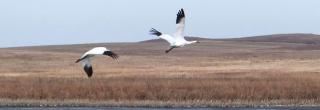

Whooping Crane Migration
The whooping cranes that make their way through North Dakota each spring are part of a population of about 500 birds that are on their way from their wintering grounds at Aransas National Wildlife Refuge in Texas to their nesting grounds at Wood Buffalo National Park in Canada, a distance of about 2,500 miles.
Whoopers stand about five feet tall and have a wingspan of about seven feet from tip to tip. They are bright white with black wing tips, which are visible only when the wings are outspread. In flight they extend their long necks straight forward, while their long, slender legs extend out behind the tail. Whooping cranes typically migrate singly, or in groups of 2-3 birds, and may be associated with sandhill cranes.
Anyone sighting whoopers should not disturb them, but record the date, time, location, and the birds' activity. Observers should also look closely for and report colored bands which may occur on one or both legs. Whooping cranes have been marked with colored leg bands to help determine their identity.
Whooping crane sightings should be reported to U.S. Fish and Wildlife Service offices at Lostwood, 701-848-2466, or Audubon, 701-442-5474, national wildlife refuges; the North Dakota Game and Fish Department in Bismarck, 701-328-6300, or to local game wardens across the state. Reports help biologists locate important whooping crane habitat areas, monitor marked birds, determine survival and population numbers, and identify times and migration routes.
